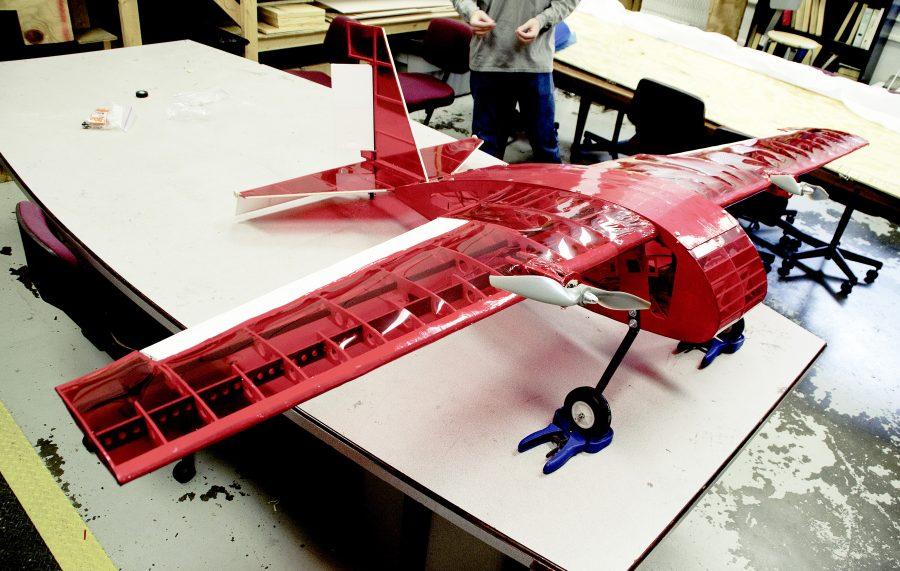 A University of Alabama team of engineering students will take flight in Wichita, Kan., for the American Institute of Aeronautics and Astronautics Student Design/Build/Fly competition this weekend.
A University of Alabama team of engineering students will take flight in Wichita, Kan., for the American Institute of Aeronautics and Astronautics Student Design/Build/Fly competition this weekend.
Over the past two semesters, 21 students designed and built a small, electrically-powered aircraft to compete against other universities around the globe.
The final product must complete four missions, three in the air and one on the ground.
“We’ve proven that we can successfully complete all the mission requirements, both flight and ground missions, that the competition requires us to do. So that’s probably the reason we’re pretty excited, because we know we can do everything that we set out to do,” Will Bowen, a team captain and senior majoring in aerospace engineering, said.
(See also: “College of Engineering sees growth“)
The tasks include flying as many laps around a pre-determined course as possible and flying the same course carrying a number of one-pound cubes. The course also includes a medical rescue simulation where “attendants” and “patients,” represented by wooden blocks, are transported for three laps. In the ground mission, the aircraft mimics a taxi, driving across 40 feet of roof paneling and avoiding obstacles.
The goal, Bowen said, is to be as light and as fast as possible to achieve the highest score. He said many of the other teams in the contest have not succeeded in all four missions during tests before competition day, which means they are already ahead of the game.
“This year we’re hoping we’re going to be one of the better teams to come through UA,” Bowen said. “We’ve hit a lot of milestones that other teams hadn’t, so we’ve got high hopes for this competition.”
The plane, cut and glued by the team, is composed of balsa wood and carbon fiber and is covered with red shrink wrap. Per competition rules, purchased motors and dual propellers are allowed. If successful, this year’s team will be the first to present a capable aircraft featuring more than one propeller.
(See also “Engineering majors to compete in aircraft competition“)
The majority of the team’s score derives from a 60-page report of their design process, articulating how the plane was built and why the students made certain configuration choices, including size and shape.
Chris Cottingham, a team captain and senior majoring in aerospace engineering, said the most difficult factor in the competition is uncertainty with the weather.
“It’s Kansas, so it’s extremely windy. That’s a big concern for us. Down here we have some wind, but we don’t have the same speeds,” he said. “You can’t necessarily design for every scenario that could possibly happen, but we did our best to design for a typical day in Kansas. That’s about the extent of what we could do in terms of preparation.”
Cottingham said his favorite part of the project was watching their aircraft fly and land on its first run-through.
“That was a very exciting day,” he said.
Another interesting part of the competition, he said, is seeing the designs of other teams.
“I’m excited to see what other teams have created and what their planes look like, and see how it compares to what we built, because there’s probably about 400 different ways you could build this aircraft,” Cottingham said.
(See also “UA Engineering, A&S open new workshop“)
Oddly enough, no one on the team has actually flown their own plane, since doing so requires a certification. Bowen said the finished product was taken to a Northport airfield twice this semester for testing, where the team was given pointers on what they could change to make for a more successful flight.
The team represents an aerospace engineering senior design project, and has met for several hours five days a week. Assisted by non-senior classmates, students in this major must choose from a variety of assignments, such as a hovercraft team and a theoretical jet design team.
Although they have never before worked together on a collaborative project, the seniors have been attending almost all of the same classes for several years because of the size of the aerospace engineering major, Bowen said.
Other senior members of the team include Corey Brown, Connor Burleson, Chris Goodeaux and Daniel Groff.
The competition, hosted by Cessna Aircraft Co. and Raytheon Missile Systems, will take place April 11 to 13.









